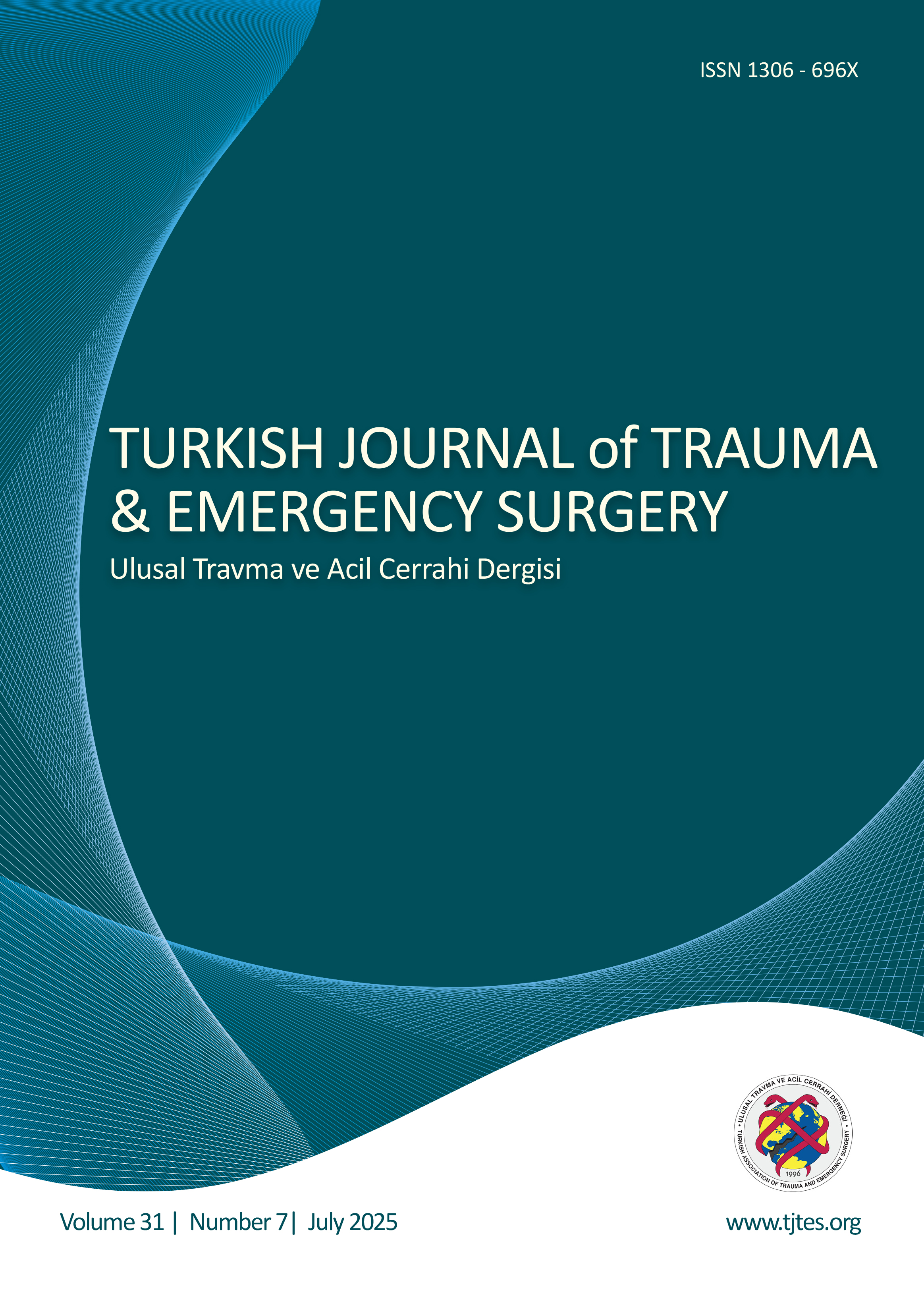Hızlı Arama
Komplike karaciğer kist hidatiğinde yönetim: Tek merkez deneyimimiz
Yiğit İskurt1, Aysegul Yabaci Tak2, Sabahattin Destek3, Adem Akcakaya1, Ertan Bulbuloglu1, Kamuran Cumhur Deger41İstanbul Bezmialem Vakıf Üniversitesi Tıp Fakültesi, Genel Cerrahi Anabilim Dalı, İstanbul2İstanbul Bezmialem Vakıf Üniversitesi Tıp Fakültesi, Biyoistatistik Anabilim Dalı, İstanbul
3Üsküdar Üniversitesi Tıp Fakültesii, Genel Cerrahi Anabilim Dalı, İstanbul
4Biruni Üniversitesi, Genel Cerrahi Anabilim Dalı, İstanbul
AMAÇ: Bu çalışma, hidatik kistli hastalarda preoperatif laboratuvar ve radyolojik bulguları değerlendirerek, postoperatif komplikasyonların şiddetini tahmin etmeyi ve klinik kötüleşme belirteçlerini tanımlamayı amaçlamaktadır. Elde edilecek bulguların, tedavi stratejilerinin iyileştirilmesine, klinik karar verme süreçlerinin optimize edilmesine ve komplike hidatik hastalığın yönetiminde postoperatif yaşam kalitesinin artırılmasına katkı sağlaması beklenmektedir.
GEREÇ VE YÖNTEM: Eylül 2016 ile Eylül 2021 tarihleri arasında kurumumuzda hidatik hastalık nedeniyle cerrahi geçirmiş 74 hasta çalışmaya dahil edildi. Yüksek ASA skoru ve hidatik kist dışında karaciğer lezyonları olan hastalar çalışma dışında tutuldu. Hastalar, Clavien-Dindo sınıflamasına göre iki gruba ayrıldı: Grup 1 (hafif komplikasyonlar) ve Grup 2 (şiddetli komplikasyonlar). Tüm hastalara preoperatif ve postoperatif dönemde albenda-zol (15 mg/kg/gün) tedavisi uygulanmıştır. Klinik, demografik, laboratuvar ve görüntüleme verileri, kist özellikleri, cerrahi yaklaşım, komplikasyonlar ve postoperatif morbidite, sonuçlar ve komplikasyonlar için prediktif faktörleri belirlemek amacıyla değerlendirildi.
BULGULAR: Çalışmamızda, hidatik hastalık nedeniyle cerrahi tedavi gören 74 hastanın verileri analiz edildi ve bu hastaların ortalama yaşı 43 yıldı. Cohort, Clavien-Dindo sınıflamasına göre iki gruba ayrıldı: Grup 1 (hafif komplikasyonlar, %81) ve Grup 2 (şiddetli komplikasyonlar, %19). Pre-operatif ALP ve HGB düzeylerinde, iki grup arasında istatistiksel olarak anlamlı farklar gözlemlendi (p<0.05). Grup 1'de çoğu hasta basit kistlere sahipken, Grup 2'de komplikasyonlu kistlerin (p=0.023) ve safra fistüllerinin (p=0.01) daha sık görüldüğü tespit edildi. Postoperatif komplikasyonlar, perkütan drenaj, yeniden hastaneye yatışlar ve ERCP gereksinimi, Grup 2'de daha sık görüldü (p<0.001). Ultrasonografi, BT ve MRI gibi görüntüleme teknikleri, safra yolları tutulumu gibi şiddetli morbiditeyi belirleyen önemli bir prediktif faktör olarak saptandı. Ayrıca, yüksek preoperatif ALP düzeyleri (≥133 U/L), postoperatif morbiditenin önemli bir risk faktörü olarak belirlendi. ROC analizi, ALP düzeyi ≥133 U/L'in %64.29 hassasiyet ve %86.67 özgüllükle, 0.805 AUC değeri ile postoperatif komplikasyonları tahmin etmede önemli bir belirteç olduğunu göstermektedir. SONUÇ: Karaciğer hidatik kistlerinin yönetimi, cerrahi beceriler, farmakolojik tedavi ve hastalığın patofizyolojisi hakkında derinlemesine bir anlayışı entegre eden multidisipliner bir yaklaşım gerektirir. Sürekli araştırmalar, tedavi stratejilerinin geliştirilmesi, cerrahi sonuçların iyileştirilmesi ve hastaların yaşam kalitesinin artırılması için önemlidir. Bulgularımız, kist tipi, postoperatif drenaj ihtiyacı, hastaneye yatışlar, hastanede kalış süresi, preoperatif ALP düzeyleri ≥133 U/L ve safra yolları tutulumu gibi belirli klinik faktörlerin, hidatik hastalık cerrahisi geçiren hastalarda postoperatif morbiditeyi anlamlı şekilde tahmin ettiğini vurgulamaktadır.
Management of complicated hepatic hydatid cysts: Our single-center experience
Yiğit İskurt1, Aysegul Yabaci Tak2, Sabahattin Destek3, Adem Akcakaya1, Ertan Bulbuloglu1, Kamuran Cumhur Deger41Department of General Surgery, Bezmialem Vakif University Faculty of Medicine, İstanbul-Türkiye2Department of Biostatistics, Bezmialem Vakif University Faculty of Medicine, İstanbul-Türkiye
3Department of General Surgery, Üsküdar University Faculty of Medicine, İstanbul-Türkiye
4Department of General Surgery, Biruni University Faculty of Medicine, İstanbul-Türkiye
BACKGROUND: This study aims to evaluate preoperative laboratory and radiological findings in patients with hydatid cysts to predict the severity of postoperative complications and identify markers of clinical deterioration. The goal is to refine treatment strategies, optimize clinical decision-making, and improve postoperative quality of life in the management of complicated hydatid disease.
METHODS: This retrospective study included 74 patients who underwent surgical treatment for hydatid disease at our institution between September 2016 and September 2021. Patients with high American Society of Anesthesiologists (ASA) scores or hepatic lesions other than hydatid cysts were excluded. Based on the Clavien-Dindo classification, patients were categorized into two groups: Group 1 (mild complications) and Group 2 (severe complications). All patients received preoperative and postoperative albendazole therapy (15 mg/kg/day). Clinical, demographic, laboratory, and imaging data, along with cyst characteristics, surgical approach, complications, and postoperative morbidity, were analyzed to identify predictive factors for outcomes and complications.
RESULTS: Data from 74 patients who underwent surgery for hydatid disease were analyzed, with a median age of 43 years. The cohort was divided into two groups based on the Clavien-Dindo classification: Group 1 (mild complications, 81%) and Group 2 (severe complications, 19%). Statistically significant differences were observed in preoperative alkaline phosphatase (ALP) and hemoglobin (HGB) levels between the two groups (p<0.05). Most patients in Group 1 had simple cysts, while Group 2 showed a higher incidence of complicated cysts (p=0.023) and biliary fistulas (p=0.01). Postoperative complications, including percutaneous drainage, readmissions, and the need for endoscopic retrograde cholangiopancreatography (ERCP), were more frequent in Group 2 (p<0.001). Imaging modalities such as ultrasonography, computed tomography (CT), and magnetic resonance imaging (MRI) identified biliary involvement as a significant predictor of severe morbidity. Additionally, elevated preoperative ALP levels (≥133 U/L) were found to be a significant risk factor for postoperative morbidity. Receiver operating characteristic (ROC) analysis showed that an ALP level ≥133 U/L had a sensitivity of 64.29% and a specificity of 86.67%, with an area under the curve (AUC) of 0.805. These findings underscore the importance of specific clinical and laboratory markers in predicting postoperative outcomes in hydatid disease surgery.
CONCLUSION: Effective management of liver hydatid cysts requires a multidisciplinary approach, combining surgical expertise, pharmacological treatment, and a comprehensive understanding of disease pathophysiology. Continued research is essential to refine treatment protocols, enhance surgical outcomes, and improve patients' quality of life. Our findings emphasize that specific clinical factors, such as cyst type, need for postoperative drainage, hospital readmissions, length of hospital stay, preoperative ALP levels ≥133 U/L, and biliary system involvement, are significant predictors of postoperative morbidity in patients undergoing surgery for hydatid disease.
Makale Dili: İngilizce




